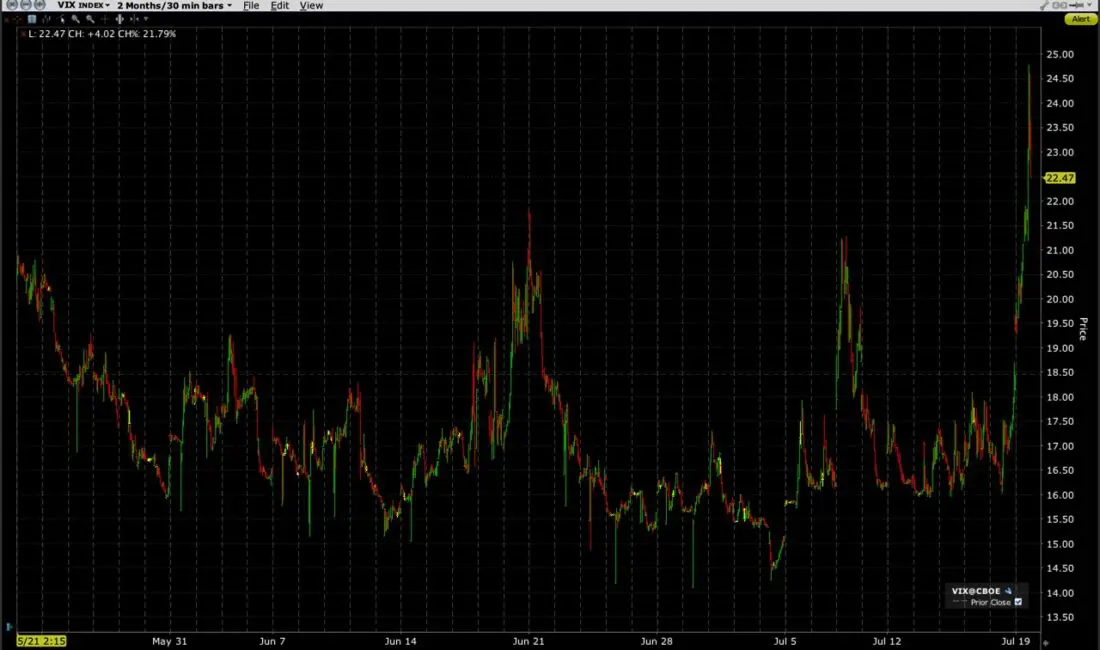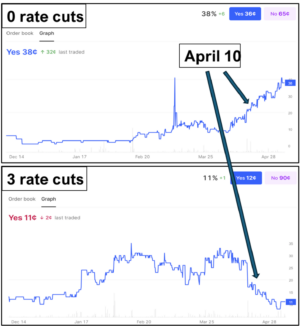I must lead off this piece with an apology. I considered writing about today’s topic at various points over the past few weeks but ended up shelving it repeatedly. So, I’m sorry that I didn’t publish about the dangers of shorting volatility in a quiet market until the markets were no longer quiet. Long-time readers know that it is standard warning of mine, but I’ve been lax about refreshing that message.
The following graphs should provide important perspective:
CBOE Volatility Index (VIX), 2 Months, 30 Minute Bars

Source: Interactive Brokers
CBOE Volatility Index (VIX), 7 Months, 2 Hour Bars


Source: Interactive Brokers
The top graph shows VIX’s recent tendency to meander at lower levels before exploding higher periodically. For most of the past two months, the index has traded in a roughly two-point range except for periodic spikes. Unless a trader was able to time a short volatility trade nearly perfectly – finding the time just before VIX returned to its prior trading range – shorting volatility has been a high-risk/low-reward trade. If someone shorted VIX when it was below 20, what could they reasonably expect to make? A point or two? Meanwhile, in just the past month, there have been three opportunities to lose 5-6 points. Pardon me, but I don’t like those odds. Human nature is such that volatility effectively has a lower bound. Even the most boring markets move a little, and traders are unlikely to offer volatility at too low a price. They know the risk of quick reversals and demand compensation for taking that risk.
To be fair, there were more opportunities to make money by shorting volatility earlier this year. Over the course of the past few months, we have seen the prevailing VIX trading range sink from 20-22 to 16-18, with much of that drop occurring in the March-April period. That was also the only period that didn’t feature a sharp spike higher in VIX. That was indeed a solid time to bet against volatility, with fiscal stimulus washing through the economy and the Federal Reserve resolutely continuing its monetary stimulus. We can – and do – question whether it is appropriate for traders to pare their volatility assumptions now that the possibility for future fiscal stimulus is tenuous at best and the path of monetary accommodation is more uncertain that it was, but we did enter a period of generally lower volatility this spring.
As I write this, I don’t have sufficient clarity to know whether today is yet another in a series of one or two-day dips that have proven to be buying opportunities, or whether there is a more significant change in sentiment. My opinion is that the plunge in 10-year yields is primarily about a flight to safety spurred by returning Covid worries that are pressuring the reopening and inflation trades. Lower oil prices, which might normally be taken as a positive sign for shrinking inflation, are instead feeding into worries about slowing growth. When yields decline slightly, they can be used as a justification for higher stock valuations. When they plunge on growth fears, those fears more than outweigh the lower discounting factor.
Today’s move could yet prove to be another fleeting hiccup in the markets’ steady advance and an opportunity to sell volatility at higher levels. If that is the case, I could say that I can outline a better case for selling volatility today than there was last week. If today represents more of a sea change in sentiment, the risk/reward of selling volatility would still be unfavorable.
Disclosure: Interactive Brokers
The analysis in this material is provided for information only and is not and should not be construed as an offer to sell or the solicitation of an offer to buy any security. To the extent that this material discusses general market activity, industry or sector trends or other broad-based economic or political conditions, it should not be construed as research or investment advice. To the extent that it includes references to specific securities, commodities, currencies, or other instruments, those references do not constitute a recommendation by IBKR to buy, sell or hold such investments. This material does not and is not intended to take into account the particular financial conditions, investment objectives or requirements of individual customers. Before acting on this material, you should consider whether it is suitable for your particular circumstances and, as necessary, seek professional advice.
The views and opinions expressed herein are those of the author and do not necessarily reflect the views of Interactive Brokers, its affiliates, or its employees.
Disclosure: Margin Trading
Trading on margin is only for sophisticated investors with high risk tolerance. You may lose more than your initial investment. For additional information regarding margin loan rates, see ibkr.com/interest
Disclosure: Options Trading
Options involve risk and are not suitable for all investors. Multiple leg strategies, including spreads, will incur multiple commission charges. For more information read the "Characteristics and Risks of Standardized Options" also known as the options disclosure document (ODD) or visit ibkr.com/occ
Disclosure: Futures Trading
Futures are not suitable for all investors. The amount you may lose may be greater than your initial investment. Before trading futures, please read the CFTC Risk Disclosure. A copy and additional information are available at ibkr.com.



























